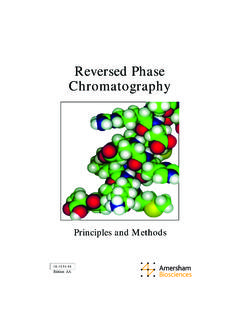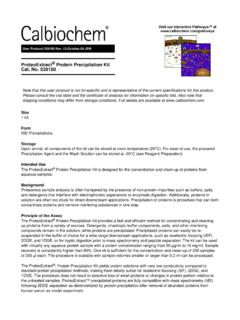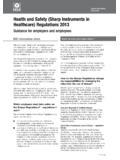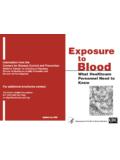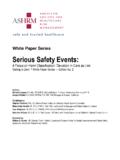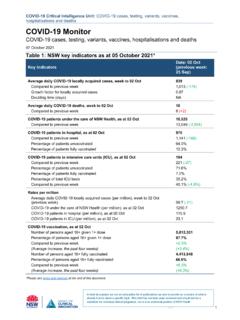Transcription of Columns XK 16, XK 26, XK 50 Packing Reservoirs RK 16/26, …
1 Instruction 28-9920-23 AFGE HealthcareLife SciencesColumns XK 16, XK 26, XK 50 Packing Reservoirs RK 16/26, RK 50XK Columns are designed for standard liquid chromatography of macromolecules. They are available in the following dimensions:XK adapters are used with XK Columns . The Columns come with one adapter and one bottom piece. A larger range of bed heights can be obtained by fitting an additional adapter at the bottom of the column (Table 2 on page 4).Opening the boxXK Columns are delivered complete with a thermostatic jacket , one adapter, one tubing cutter, one bottom piece and tubing at both ends for direct connection to valves and pumps. Unpack the XK column and the adapter carefully. Check the contents of the delivery package against the Packing list supplied. Inspect for any missing components or damage that may have occurred during transport . Report any damage immediately to the local GE Healthcare representative and to the transport company of main partsThe main parts of the column are shown in Figure 1.
2 For a detailed view of the column parts, see the exploded view, Figure 5 on page tube (5). The high-precision borosilicate glass tube has a length of 200, 300, 400, 600, 700 or 1000 1 mm with an inner diameter of 16 , 26 or 50 jacket (6). The jacket is an acrylic plastic tube with threaded ends. It encloses the chromatographic tube and is sealed to the end piece with an tube (8). The chromatographic column tube consists of the glass tube, thermostatic jacket and the respective column end end pieces (3). The red end pieces, made of reinforced acetal plastic, hold the glass tube and the thermostatic jacket in position. Each end piece houses an O-ring, a sealing ring, a washer and a locking ring. The end piece also carries a fluid connector through which fluid from the thermostat enters or leaves the bottom piece (7). The bottom piece screws onto the column end piece. The medium bed is supported by a 10 m nylon net ring, which is placed on top of a plunger (4).
3 The bottom piece is sealed to the chromatographic tube by an (1). The adapter consists of a top end cap that fits the column end piece, and a plunger that carries the net ring and support screen. It also has an adjusting knob (2) that seals the adapter to the column XK Columns are supplied with capillary tubing. The adapter tubing is 130 cm long. The bottom piece tubing is 35 cm long. The inlets on the adapter and the column bottom piece have a 5 cm protection tubing threaded over the capillary tubing. This prevents the capillary tube from being squeezed during transport and 1 XK adapter with an XK 1. Dimensions of XK columnsLength (cm) 16 26 50 mm20XK 16/20XK 26/20XK 50/2030--XK 50/3040XK 16/40XK 26/40-60--XK 50/6070XK 16/70XK 26/70-100XK 16/100XK 26/100XK 50/100234516327482 Instruction 28-9920-23 AFMaterialsUnder normal operating conditions, the only materials in contact with the eluent are: glass-fibre reinforced polypropylene, polyamide, acrylic plastic, borosilicate glass, fluoro-rubber and Columns can be used in aqueous solutions and almost all the organic solvents commonly used in liquid chromatography of macromolecules, with the following exceptions: chlorinated hydrocarbons acetone and other ketones aliphatic esters phenol Solutions containing more than 10% sodium hydroxide, 10% hydrochloric acid, other strong mineral acids or 5% acetic acid should not be used thermostatic jacket should only be used with water as cooling fluid.
4 Acrylic plastic is not resistant to alcohol, ethylene glycol or other organic column may be used at temperatures up to 40 C and pressures up to MPa (5 bar) for XK 16 and XK 26 Columns , and MPa (3 bar) for XK 50 Columns . The jacket can also withstand temperatures up to 40 C but should not be exposed to pressures higher than MPa (2 bar).CleaningSuitable cleaning agents are soapy water or laboratory detergents. Enzyme detergents are recommended for removing proteinaceous column can be autoclaved without the thermostatic jacket , tubings and net ring. Alternatively, the entire column may be sterilized with ethylene :It is important to always loosen the black adjusting knob before inserting or removing the bottom piece and the column the adapter or the bottom pieceSee Figure 5 for the black adjusting knob (5).2 Unscrew the end cap (6, 19) and loosen the adapter (1) from the holding the inner shaft (8), unscrew the plunger (11).
5 4 Before autoclaving, remove the O-ring (10). For XK 50, remove the expander ring net ring (13) may now be removed from the plunger (11) with a sharp the net ring and support screenSee Figure 2 for the net ring (3) with a sharp the support screen (2) from the the new support screen (2) and net ring (3) on the plunger (1).4 Press on the net ring (3).Note: If the net ring is difficult to press on, it can be warmed in hot water at 50 C to 60 C prior to placing it on the 2 Replacing the net ring and the support screen on the the adapter1T ighten the inner shaft firmly to the plunger (Fig 3a and 3b).Fig. 3 T ightening the plunger onto the inner shaft .2 Adjust the O-ring on the plunger against the adapter shaft using the adjusting knob (Fig 3c). Do not adapter is now ready for (a)(b)(c)(c)Instruction 28-9920-23 AF3 Reassembling the bottom piece1T ighten the inner shaft firmly to the plunger (Fig 3a and 3b).2 Adjust the O-ring on the plunger against the bottom end cap using the black adjusting knob (Fig 3c).
6 3 Screw the bottom piece (7) into the column end piece (3) (Fig 1). 4T ighten the adjusting knob to obtain a good seal. Do not the capillary tubing1 Dismantle the bottom piece or the the ferrule and the existing capillary the new tubing through the inner shaft (Fig 4a)4 Use the tubing cutter to shorten the tubing to the minimum length needed to connect the column to the instrument .Fig. 4 Passing the new tubing through the inner shaft .5 Put on a new ferrule and screw the plunger onto the inner shaft .6 Reassemble the bottom piece or the adapter (Fig 4b).Dismantling the Columns XK 16 and XK 261 Unscrew the bottom piece and the the dismantling tool to unscrew the locking rings and to free the chromatographic tube. 3 Remove the sealing ring, washer and chromatographic tube. 4 Unscrew the column end pieces from the thermostatic jacket and remove the the column XK 501 Unscrew the bottom piece and the column end pieces from the thermostatic jacket and remove the : The XK 50 column chromatographic glass tube is held in position by built-in sealing rings in the end piece.
7 Washer and locking rings are not the Columns XK 16 and XK 261 Put the chromatographic glass tube into the thermostatic jacket .2 Install one of the end pieces by screwing into the thermostatic jacket , ensuring that the O-ring is in a sealing ring at the end of the glass tube followed by a in the locking ring with the dismantling steps 2 to 4 for the other end of the the column XK 501 Screw the two end pieces onto the thermostatic jacket . Ensure that the metal spring-rings are seated in the built-in sealing rings and that the O-rings are in place in the end the built-in sealing rings with water. Slide in one end of the chromatographic glass tube through the built-in sealing ring, thermostatic jacket and finally through the built-in sealing ring of the other end piece. Push the tube towards the second sealing ring. Use a small screwdriver or a similar blunt tool to carefully ease the sealing ring over the : It is important to properly tighten the bottom piece and the adapter to the end piece.
8 (a)(b)Caution: Since the XK 50/100 chromatographic glass is very heavy, it can easily slide out from the built-in sealing rings. To keep the tube in position when washing the column, screw the conical adapter (supplied with Packing reservoir RK 50) to one of the end pieces of the column and hold that end downwards while washing. After washing, screw the bottom end piece into the end piece before mounting the column : Ensure that the distance from the sealing ring to the end of the chromatographic glass tube is equal at both the 28-9920-23 AFTable 2. The maximum bed heights (cm) and bed volumes (ml) possible using one or two adapters in the various XK Columns (Please see Packing Reservoirs and Column Packing on page 6) With one adapter With two adaptersColumnVolume (ml)Bed height (cm)Volume (ml)Bed height (cm)XK 16 16 16 16 26 26 26 26 50/200-2740-140-2740-14XK 50/30265-55914-280-5590-28XK 50/60794-108840-56500-108826-56XK 50/1001588-186281-951274-186265-95 Instruction 28-9920-23 AF5 Fig.
9 5 Exploded view of XK column with XK plug3 Tubing connector4 Capillary tubing5 Adjusting knob6 Top end cap7 Adapter shaft8 Inner shaft9 Ferrule10O-rings11 Plunger12 Support screen13 Net ring14 Column end piece15 Fluid connector from/to the thermostatic jacket16O-ring17 Glass tube18 Thermostatic jacket19 Bottom end cap20 Dismantling tool21 Column tube22 Bottom piece6 Instruction 28-9920-23 AFPacking Reservoirs and Column PackingColumn PackingPacking the column can be performed using either a Packing reservoir (Fig 8) or an extra column tube, which is attached via a Packing connector (Fig 7). Detailed procedure for column Packing is described in the Instructions for each gel medium and also in the Gel Filtration Handbook Principles and Methods (Code 18-1022-18). Packing ReservoirsThe Packing Reservoirs are available as RK 16/26 and RK 50. Each unit consists of a cylinder with a conical adapter. The reservoir can also be used as an eluent container.
10 For chemical resistance, see Spare parts Column on page 10. The Reservoirs can withstand temperatures up to 50 C and pressures up to MPa (5 bar).Column Packing ProceduresPacking the column using a Packing reservoir1 Remove the column adapter and replace it with the appropriate conical adapter (Fig 8). Make sure the column end piece is in the right place and the O-ring installing the appropriate cylinder on the conical adapter, pour a small amount of Packing liquid into the column tube and let it drain until the level of liquid in the tube is 1 to 2 mm above the bottom net the column outlet on the bottom piece using a stop fill chromatography medium through the Packing reservoir into the column tube. Avoid introducing air the cap on the Packing reservoir and make sure the liquid is pressed through the capillary to avoid trapping any the capillary to the system and follow the Packing instructions provided in the media the capillary from the the Packing the adapter at an angle, so that no air is trapped in the column (Fig 6a and 6b).



